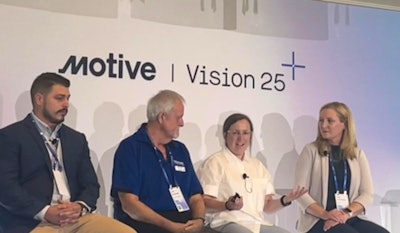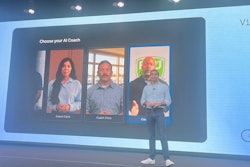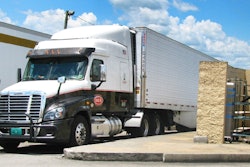
A crucial step to a comprehensive coaching program is securing driver buy-in.
In most cases, what prevents fleets from having an effective safety program is simply a case of not knowing how or what resources to use, said Julie Vasquez, product marketing lead at Motive, Tuesday during the company’s annual summit Vision 25, held in Austin.
Convincing drivers that coaching was a good thing was the first hurdle they had to jump, said Robert Fountain, field training and safety manager at Gemaire Distributors, a distribution company for AC units, HVAC, and refrigeration.
“We sat with them, saying, 'Look, we coach now. This is going to be better for us in the future,'” Fountain said.
After a multimillion-dollar accident affected their bottom line, Fountain said the company decided to coach its teams better, starting with regional managers, using Motive’s system. For high-risk events, Fountain said it has to be addressed within 24 hours.
The first month, however, became a bit overwhelming as the team received thousands of alerts.
What became pertinent, Fountain said, was not letting the alerts just pass through and insisting that when the alert comes through, particularly if they’re high risk involving a distracted driver or cell phone usage, immediately the branch manager has to sit down, coach the driver, and document the event within the Motive system.
In addition, the company followed up with drivers with a 10- to 15-minute assigned training to explain why improper driving techniques is high-risk. Fountain said that helped keep the number of accidents down.
“When we start to sit them down with a video to explain exactly what they should expect, we’re not losing drivers anymore. Coaching and education is the biggest heart of what we do,” Fountain said.
In 2022, Fountain said they had a total of 17 significant accidents for that year. After a year and half of incorporating Motive, the number went down to five.
Driver turnover also comes into play, said Daniel Patterson, director of safety at Western Express, an over-the-road trucking company with 3,600 trucks and over 4,000 drivers.
“They come to an over-the-road company like ours, they get their training, their experience, and then they move on for a local position or a position that we’re not able to offer in that same respect," Patterson said.
With that in mind, he said they make sure they address drivers individually and offer a tailor-made coaching program where it’s “not just trying to fit every driver in the same box.”
Western Express’ safety program involves coaching conversations and pulling internal data as well as driver data from Motive to create a scorecard for the driver, which is linked to a safety incentive program.
In the initial stages of implementing a coaching structure, Patterson said flexibility was key, adjusting to meet needs as necessary, as was acting on the data the company received from Motive while keeping the end goal in mind.
“It’s great to have everything set up, but you need to have daily, weekly, and monthly feedback and data showing that the information you have is being acted on," he said.
Incorporating a system like Motive may make drivers feel like Big Brother is watching them, Fountain said, but that's not the goal.
“It’s re-educating. It’s not Big Brother. It’s somebody there to help you when you’re driving that vehicle. So, for us, it became a tool to educate them,” he added.
For Western Express, Patterson said it was about setting the expectations with drivers and the safety goals they wanted to achieve.
“You have a conversation with the driver and set the expectation of, 'hey, I’m not watching you all day,' but then also know that this is a coaching tool. This is not checking the boxes to try to fire you, or we’re not trying to use this to spy on you throughout the day," Patterson said.
Companies also need to be strategic in managing the amount of data they receive.
Patterson said Western Express splits up its team and partners them with the fleets they work with. Each team has a safety manager, assistant manager, and a law guard that partners with the fleet.
“The purpose of safety is not to hold any operations back,” Patterson said. “It is to make sure that we can deliver more freight on time and to have fewer accidents and run safer miles – that’s our entire goal. So really, (it’s important to have) that partnership there.”
Another aspect is getting drivers engaged in performance-based or safety-related programs.
One of the things that have helped is having bilingual meetings with all drivers, Fountain said, as well as a lot of pre-education and offering incentives for high performances.
For fleets who may have never installed cameras or haven’t started a coaching program, Fountain said to first have a hard look at your fleet, “What are the problems that you want to address? What are the behaviors that are leading to those issues? What kind of violations are happening? Get into specifics of your issues and then look at where the behaviors that are driving that issue.”
Patterson agreed, and added that if they see an issue from a driver, they look at previous video and data content and look for certain behavior that could be leading to it.
Getting the buy-in from the leadership team is also important, Patterson said.












